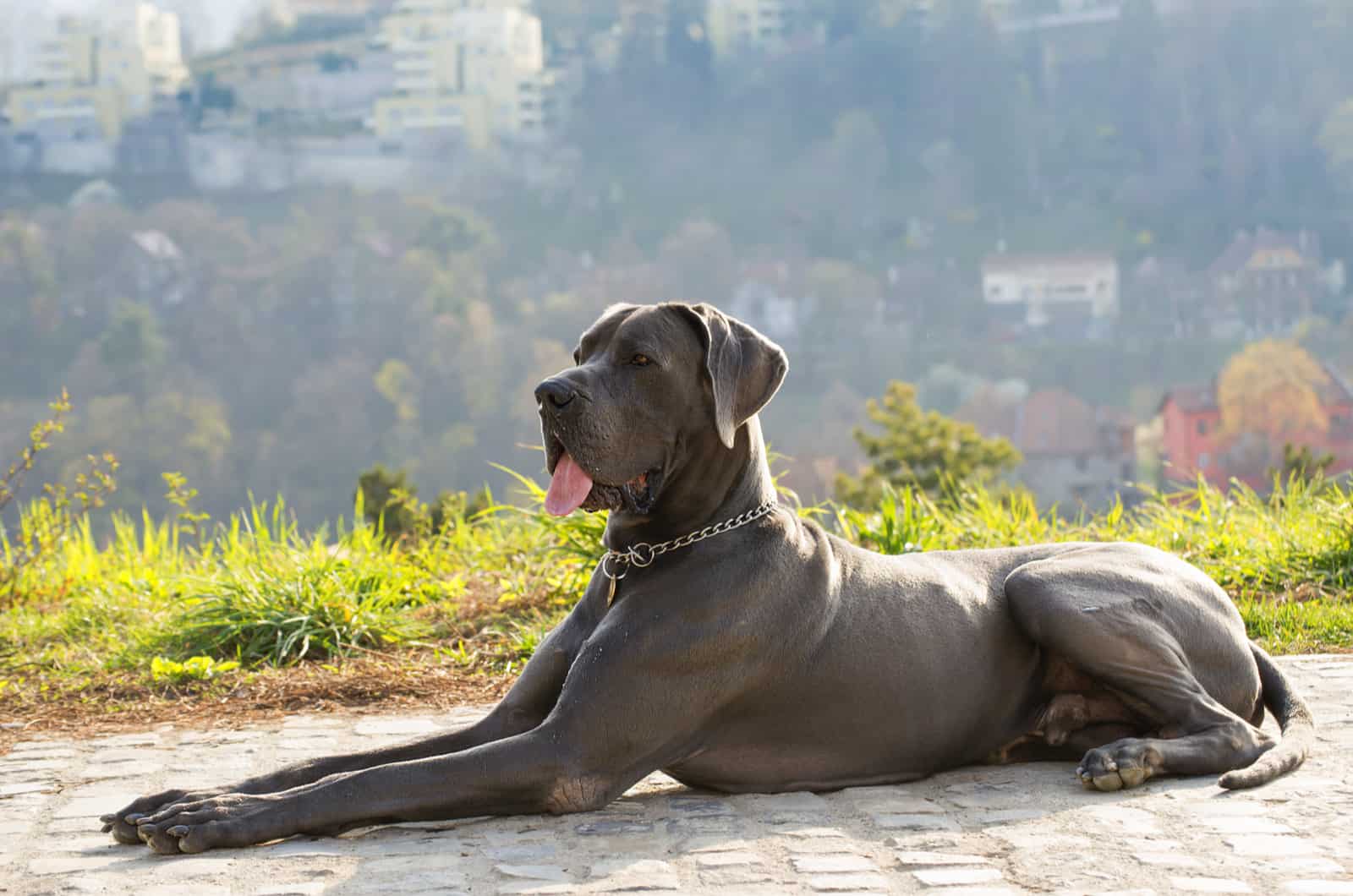The Great Dane is the gentle giant of the canine world. Despite it being one of the largest dog breeds out there, these pups are, in fact, quite kind.
Actually, they can even be considered scaredy-cats, which is why it shouldn’t be a surprise that the most popular Great Dane worldwide is the cartoon character, Scooby-Doo!
Other than their tremendous size, Great Danes are known for a large number of colors they can come in. In fact, there are eight Great Dane colors that have been accepted by the American Kennel Club (AKC)!
But, what does the term ‘standard colors’ even mean? And, do Great Dane colors matter? To help you understand coat colors better, we have prepared a list of all the Great Dane colors, while also providing you with a few more bits of information you might consider useful.
Let’s get right into it!
Great Dane Color Chart
Before we get started, take a look at this Great Dane color chart to get a better understanding of standard and non-standard Great Dane colors (according to the AKC):
[table id=258 /]
Standard Colors of Great Danes
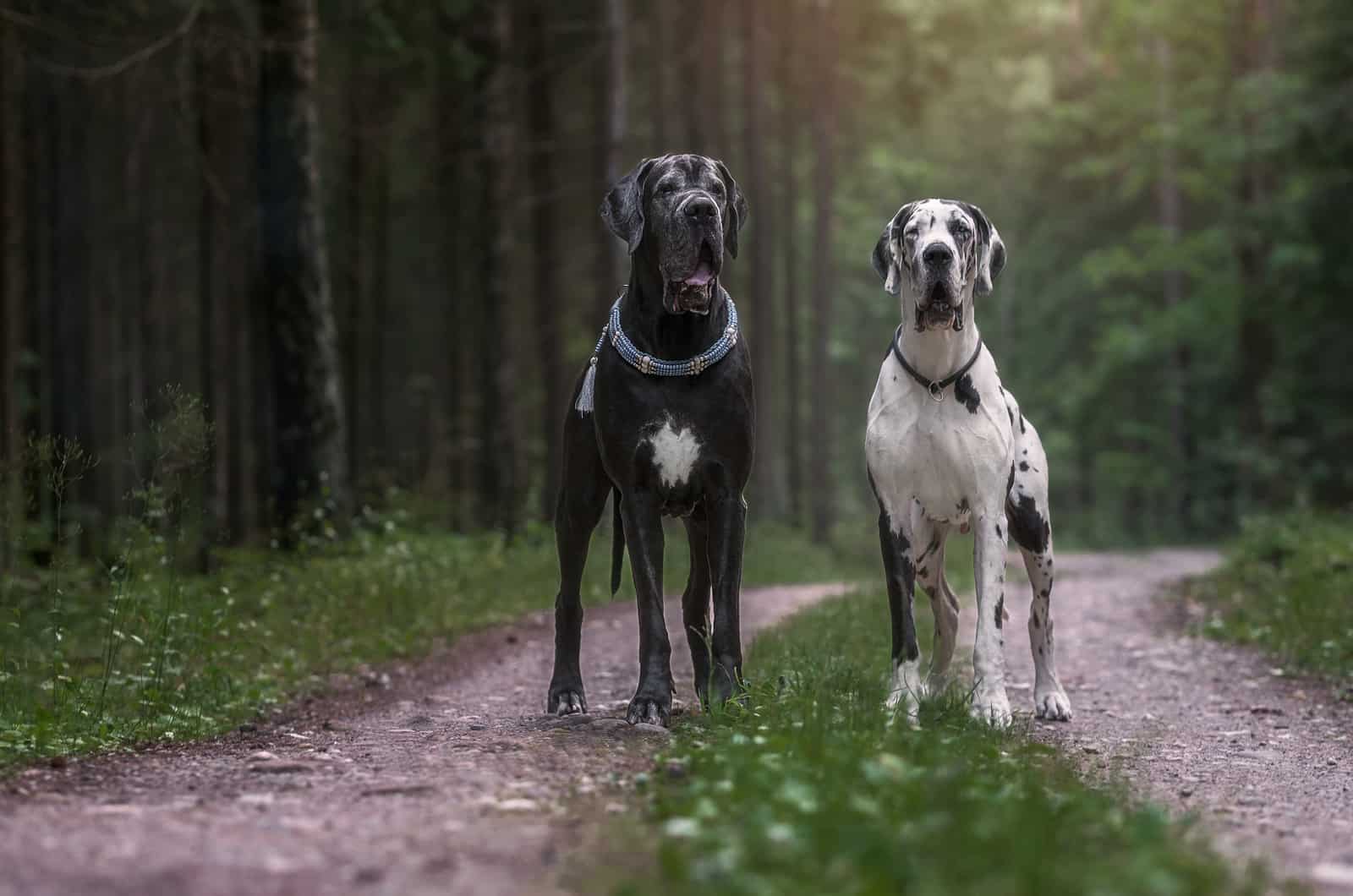
Standard colors are coat colors that have been recognized by a specific kennel club. Three of the largest ones are the AKC, the United Kennel Club (UKC), and the Federation Cynologique Internationale (FCI).
It’s important to note that not all kennel clubs hold the same breed standard. Most of the time, the FCI is rather strict and allows fewer colors compared to the other two.
But, why are some coat colors and coat patterns standard while others are not?
First off, some coat colors don’t come naturally in a breed’s genetic pool. As such, their presence on the dog’s coat means that the pooch in question is likely a crossbreed.
Also, some coat colors are connected with several health problems, which is why they are rarely considered acceptable. The breed standard is supposed to help improve the breed, and as such, these risky colors are seldom recognized.
Keep in mind that some colors are recognized by kennel clubs, even though they are not accepted as a standard. This means that even though you won’t be able to use all the benefits of having a dog in a standard color, the dog is still most likely purebred.
However, even if your pooch doesn’t come in a standard color, this isn’t a reason for concern. The only difference is that you won’t be able to participate in most dog shows or to further breed your dog, but this doesn’t stop your Fido from being the best family pet possible.
Here are standard Great Dane colors according to the AKC:
Great Dane Color, Black
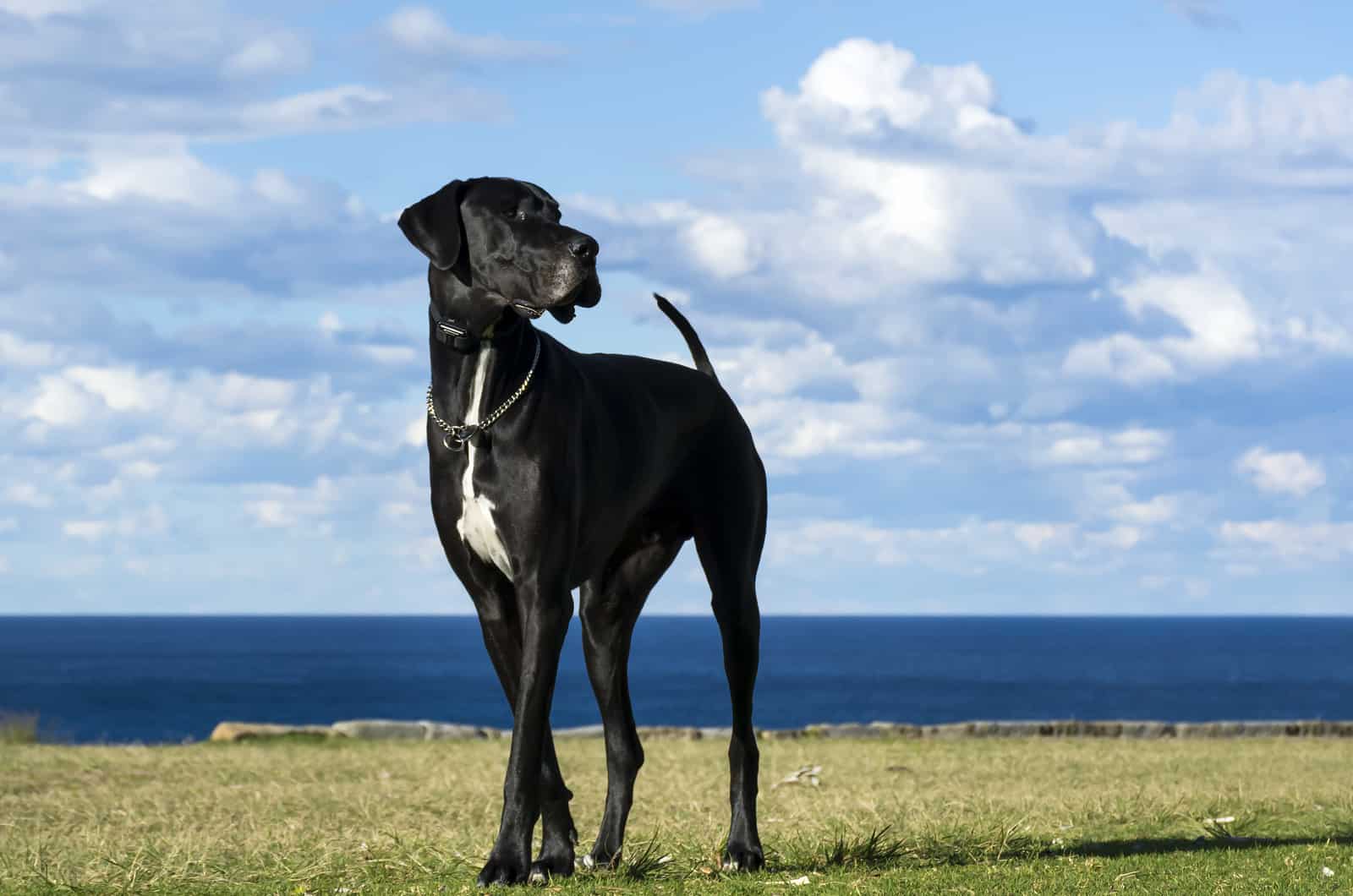
Black Great Danes have a glossy coat. Most of the time, they come in solid color, but spots can be present on their chest and toes, although this is deemed undesirable.
In fact, black Great Dane dogs can come with white markings. They will then be considered black and white Great Danes. However, these white patches shouldn’t be too large, especially if you plan on participating in conformation shows.
Read Also: Spotted Dog Breeds: 30 Dogs With Remarkable Spots
To truly make a black Great Dane’s color shine, brush them regularly with some of the best dog brushes for Great Danes. Get in the sun and see how beautiful their color sparkles in the natural light.
Black Great Danes can also come with fawn, mantle, brindle, and harlequin markings. However, these are not considered standard colors, and they are entirely undesirable.
When it comes to black Great Dane puppies, these are mainly born from black Great Dane parents. As black is a dominant gene, it is very rare for it to stay hidden before being expressed in the offspring.
Still, sometimes harlequin, blue, and mantle Great Danes can give birth to black Great Dane puppies.
Great Dane Colors, Brindle
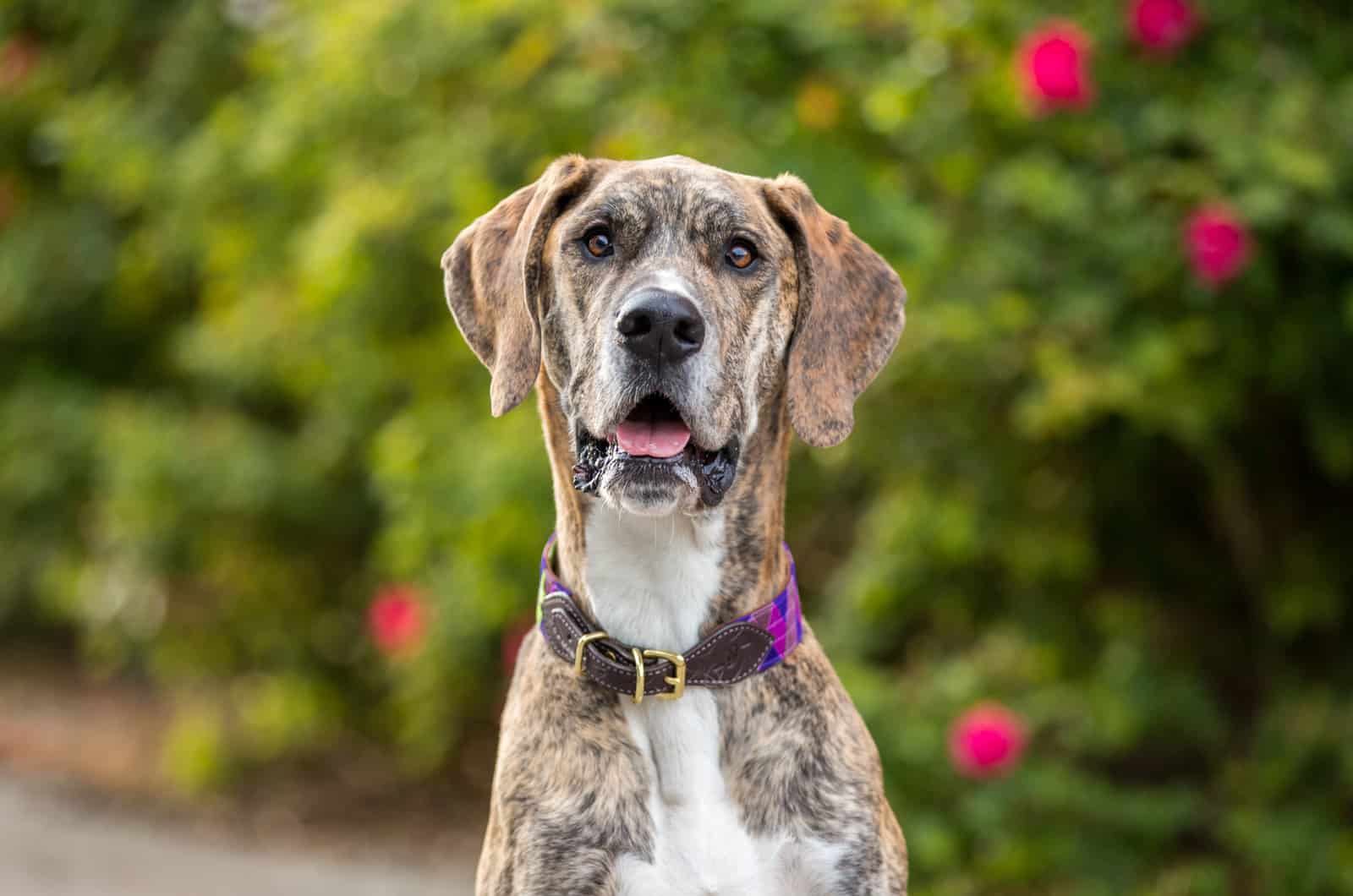
Have you seen striped dogs? These puppies can sometimes look like little canine tigers! This striped pattern is known as brindle, and it is the most dominant coat color in canines.
While brindles can come in any coat color, when it comes to Great Danes, the most common one is yellow-gold with black stripes. This is the only brindle shade accepted for this breed.
Also, brindle Great Danes have a black mask and a chevron pattern. The mask usually appears only on the muzzle, eye rims, and eyebrows, but sometimes it can spread to the ears. The tip of the tail can also be black.
Overall, the brighter the base color, the more preferred the pattern is. A distinct brindle pattern is also sought after, as it creates a contrast that’s hard not to notice.
According to the breed standard, the markings shouldn’t be too dense or too far apart, and regular striping distribution is more desirable compared to irregular, seemingly random stripes.
Many brindle Great Danes have a white chest and white toes. However, this isn’t acceptable according to the breed standard, and such dogs don’t do well in dog shows.
Also, while golden-yellow and deep yellow-brown are very popular, the same cannot be said for darker colors.
Some brindle Great Danes have a so-called dirty look because the patterns aren’t clear enough. This, too, is undesirable. The same could be said for black-fronted brindles.
As brindle is a dominant coat color, it cannot be hidden in the dog’s genetics. In other words, only two brindle dogs can produce a brindle puppy. The only exception is the fawn color, as occasionally fawn Great Danes can give birth to a brindle puppy.
In fact, crossbreeding a brindle and a fawn Great Dane can be a good idea, as it’ll ensure the coat color stays bright. This is what many breeders do to ensure a high-quality pattern that will do well in dog shows.
Great Dane Colors, Blue
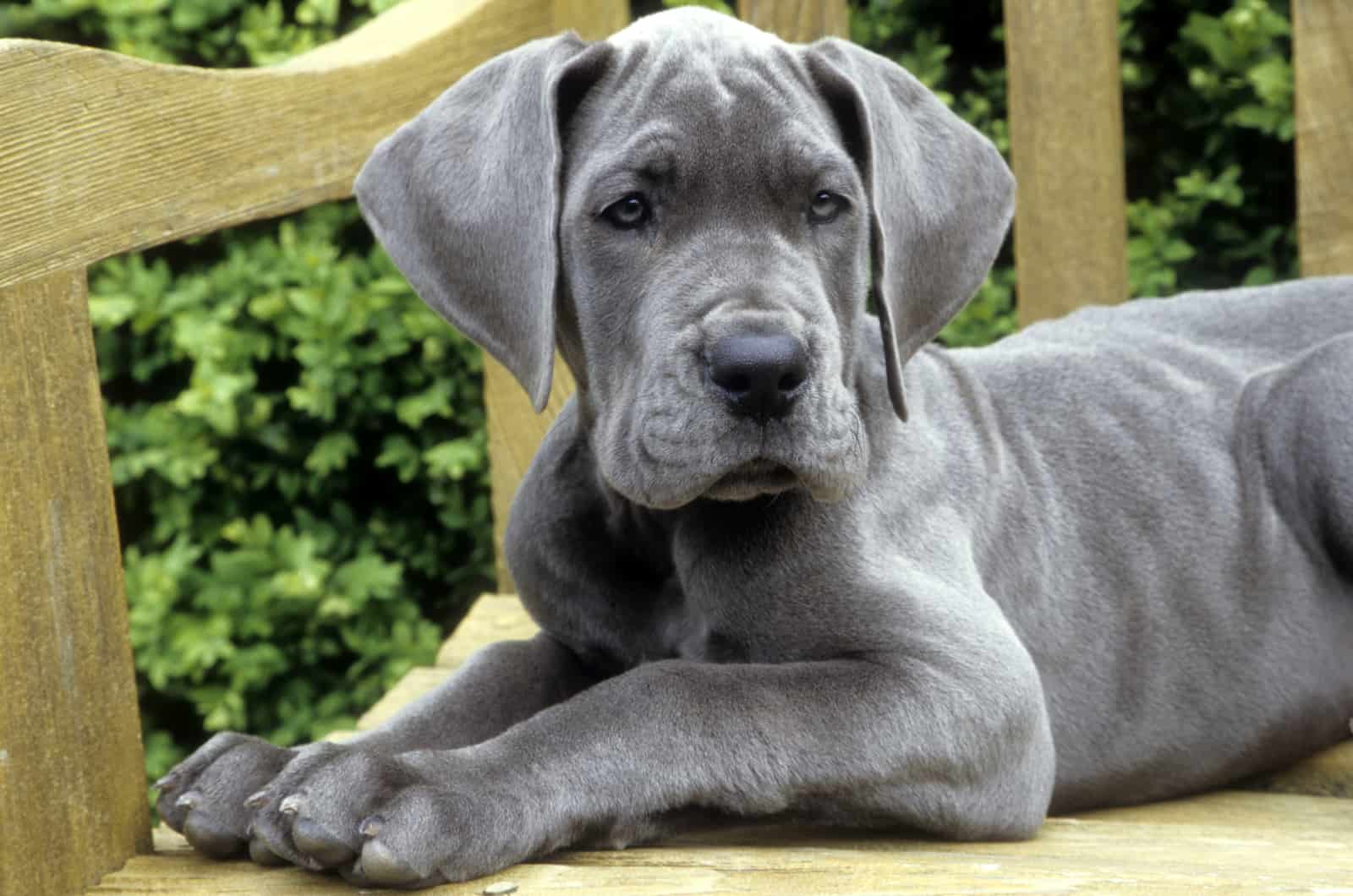
A blue coat color is caused by a dilution gene that taints the black coat and turns it into a greyish-blue shade. As such, some people consider it to be a variant of a black Great Dane, even though it is recognized as its own color.
The most desirable blue shade in Great Danes is pure steel blue, but some dogs can be of darker or lighter color.
What’s unique about this Great Dane color is that the dilution gene doesn’t affect only the coat color. In fact, it also dilutes the color of the dog’s skin and eyes. Because of this, most blue Danes will also have blue eyes and a blue nose, as well as blue paw pads, eye rims, and lips.
Some blue Great Danes can have brindle, fawn, or white markings, but they are not recognized by the AKC. In fact, none of these pups can get a pedigree.
The blue color is caused by a recessive gene. As such, it is possible for two black Great Danes to produce a blue one. Two blue Great Danes will most likely also give birth to a blue puppy.
What’s unique about blue Great Danes is that they don’t necessarily have to have a blue coat to be considered ‘blue’, although these dogs are considered faulty and not up to the AKC standards.
What do we mean?
The dilution gene dilutes the pigment all over the dog’s body, not just the coat. It can be present in the DNA of dogs of any other color, such as the fawn or even the brindle coat.
If this happens, the gene won’t affect the coat color, but it will alter the color of the dog’s nose, eye rims, lips, and paw pads, and sometimes even his eyes. But, because it won’t have effects on any color other than black, it will stay the same.
As such, it is possible to get a blue fawn or even a blue brindle. These pups will look standard, but they’ll have a blue nose instead of a black one.
Despite the coat color, as long as their nose and skin are blue, these dogs will be considered blue Great Danes.
Great Dane Colors, Silver
Silver Great Danes are the result of the same genetics as blue Great Danes, as the color of their coat is the result of black dilution. However, the biggest difference is the exact coat shade they have.
Silver Danes will have a coat in light grey color. Not just that, but their coat will have a bright shine to it, just like glossy black Great Danes have. This will give them the appearance of a dark silver color, even though they are technically considered blue or grey.
Just like blue Great Danes, they’ll likely have blue eyes, and their nose and paw pads will always be blue. White markings on the chest are common, but undesirable, though you’ll still be able to enroll your silver pup in a dog show.
Silver pups cannot have any black on their coat or on their body.
To get a silver Great Dane, breeders usually mate two silver Great Danes together, although black and blue Great Danes can also have a silver puppy in their litter.
Great Dane Fawn Color
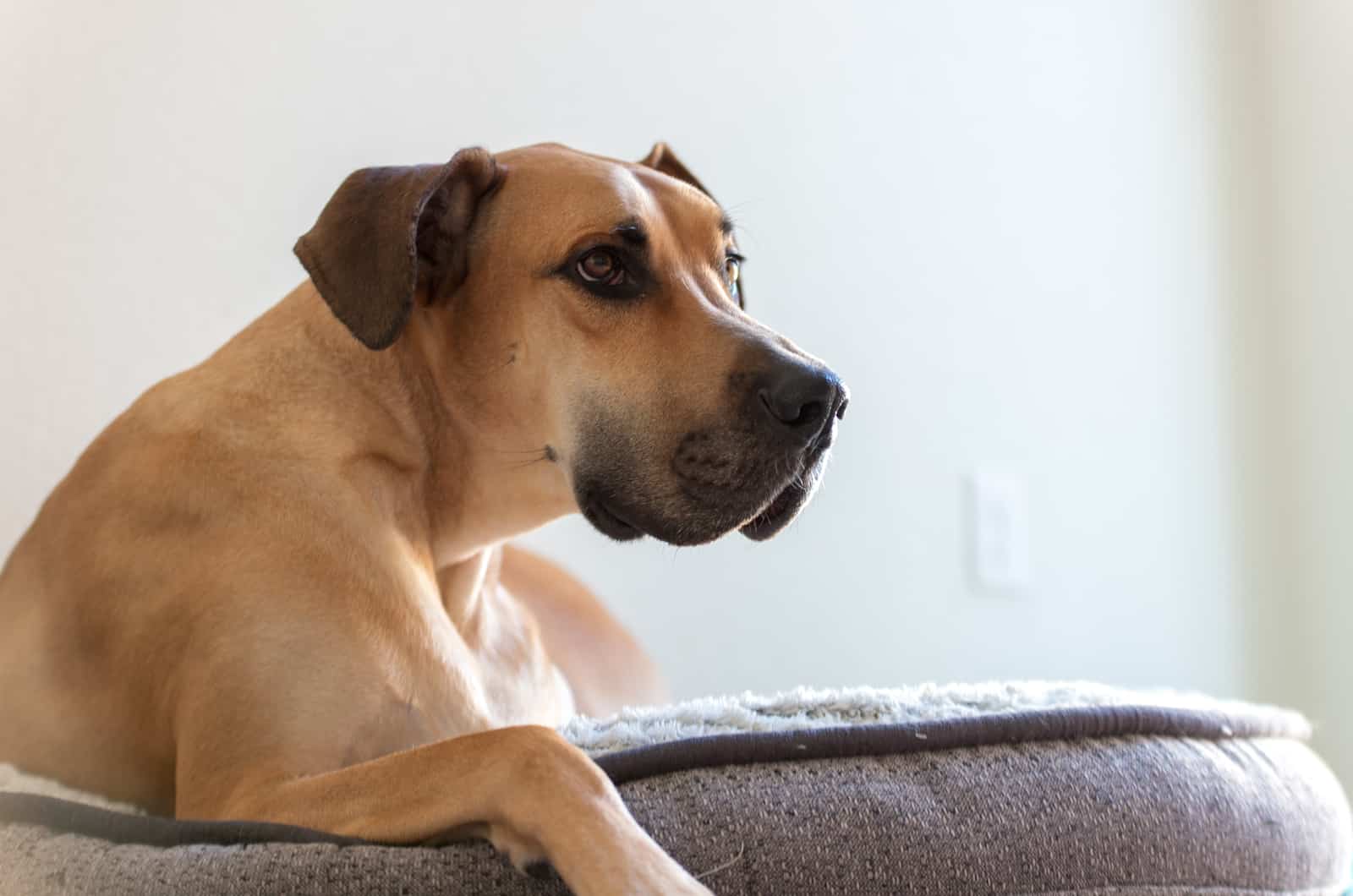
When most people think of Great Danes, they imagine them in the fawn color. In fact, this is the most common coat color in most of these pups.
Fawn Great Danes have a deep shade of a yellow gold coat. While it can come in other hues, this is the one that is preferred.
Fawn Great Danes have a black mask that goes over their eye rims and eyebrows, but it can appear on the dog’s ears and tip of the tail alike. The deeper the black shade, the more desirable is the coat color.
While white markings are possible, and are recognized by the AKC, they aren’t desirable, and most dog shows won’t accept Danes in this shade. The same goes for so-called dirty-colored fawns.
Also, fawn Danes shouldn’t have any marking on them (other than the mentioned black mask), especially not in black, blue, or harlequin color.
Most fawn Great Danes are the product of crossbreeding fawn, brindle, and harlequin pups.
Great Dane Colors, Harlequin
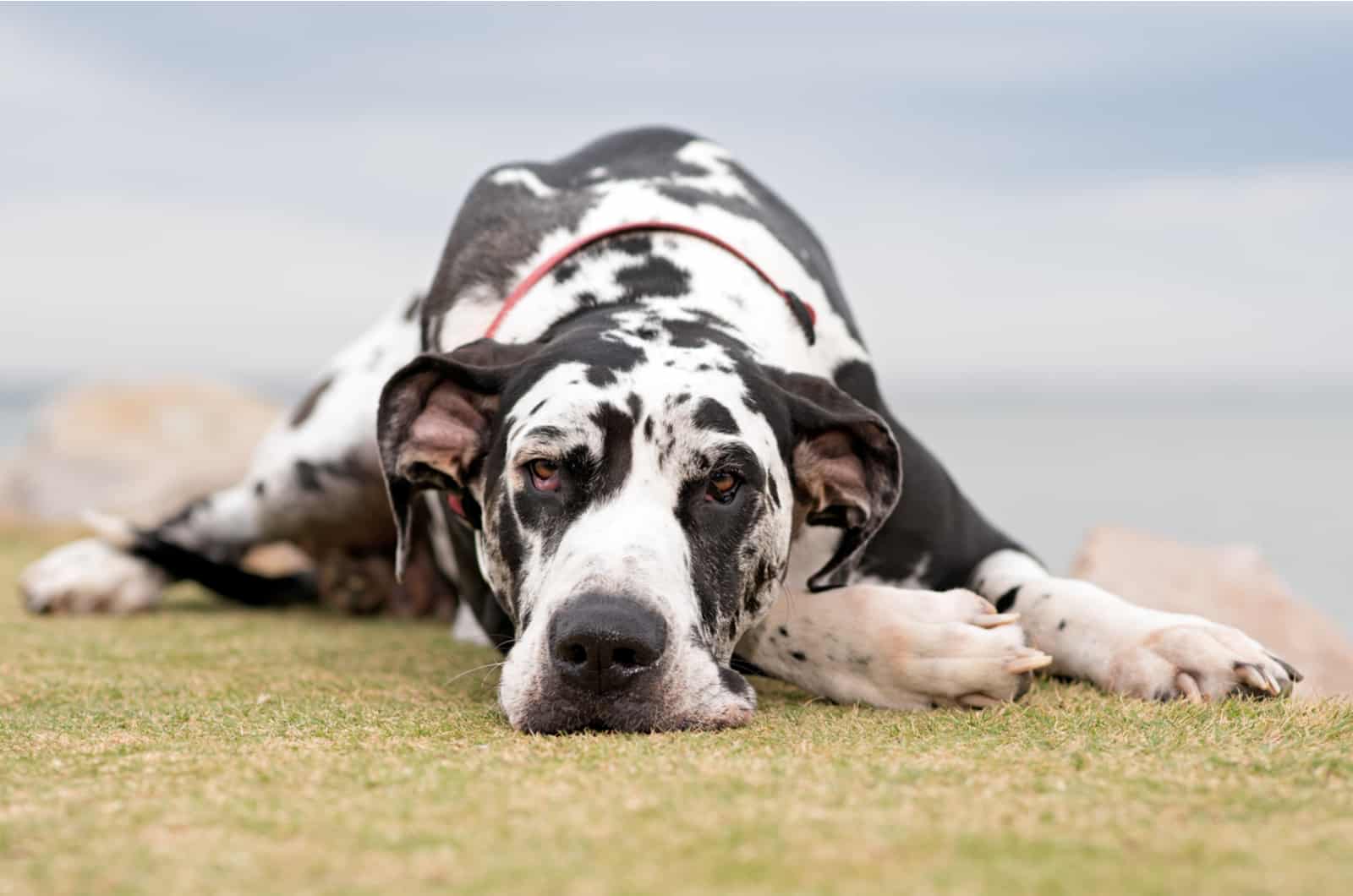
Harlequin Great Danes are very easy to differentiate from other Great Dane colors. Unlike most other colors that are entirely solid, harlequin Great Danes have black patches on a white base coat.
This base color has to be pure white, and not in any other color. The black markings are irregular, but they aren’t spots as you can see in Dalmatians, and they don’t look the same as the piebald markings.
These patches are well distributed all over the dog’s body, but the neck has to be entirely, or at least partially white. Also, the patches shouldn’t be large, and they should give the dog an almost spotted appearance.
Additionally, some parts of the dog’s skin can also have patches. This is most notable on the dog’s nose, which will usually be in pink and black color.
The dog should always have more white than black on its coat. Otherwise, it would be considered a black and white Great Dane.
Occasionally, you may notice grey patches mixed with black. While they are permitted, they aren’t desirable, and no dog show will accept such dogs.
Individual strands of black hair might be noticed on the white base. They aren’t forbidden, but they can give a Great Dane the undesirable dirty (or salt and pepper) appearance.
Breeding harlequin Great Dane puppies is a huge challenge, and there is no rule as to which dogs will produce harlequin puppies. Not just that, but the dog’s pedigree cannot be decided upon until the dog matures.
For additional information, take a look at our list of the best harlequin Great Dane breeders.
Great Dane Colors, Mantle
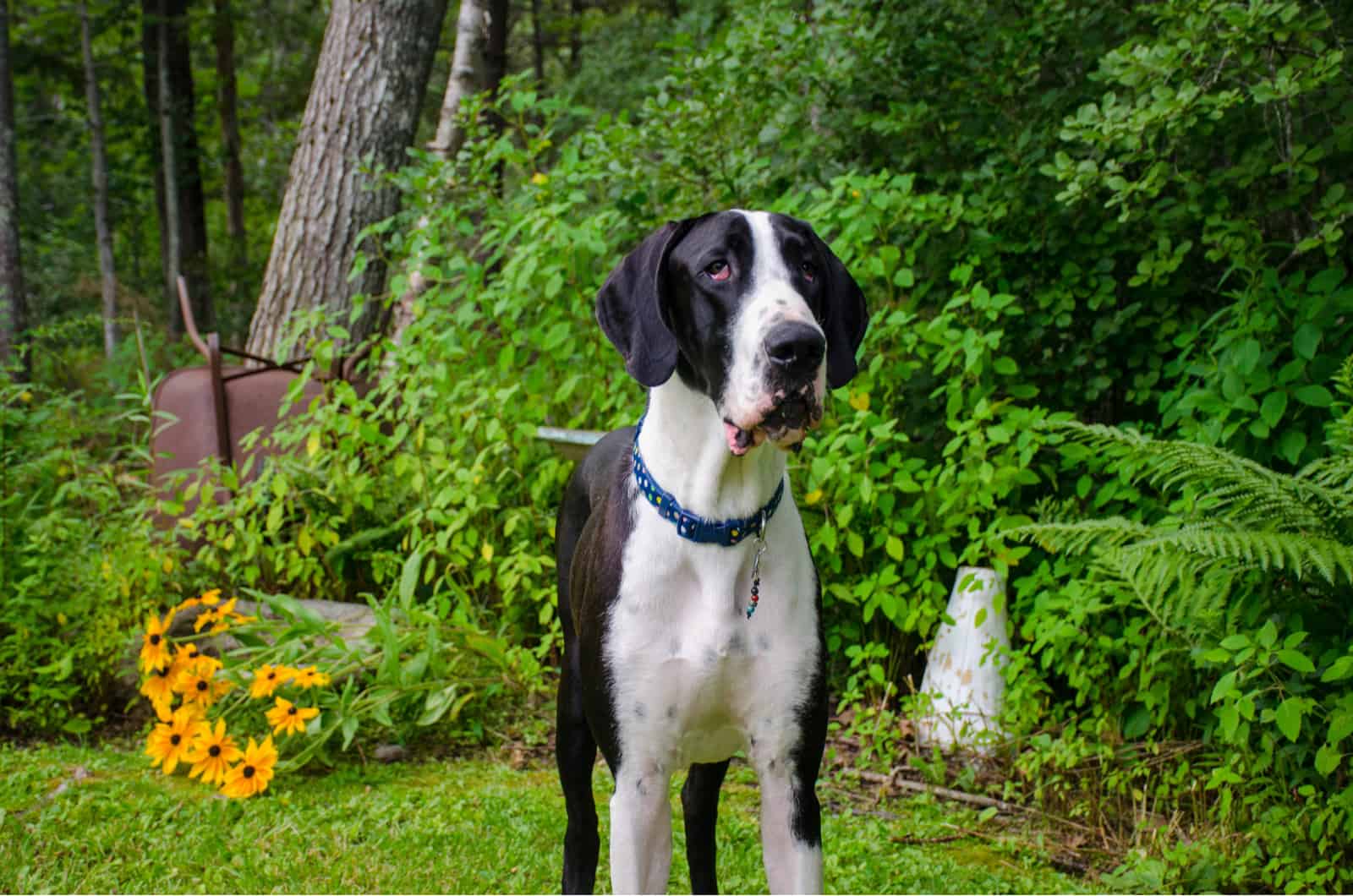
Mantle is one of the newest Great Dane colors that has been identified. Until the 1990s, mantle Great Danes were considered to be mixed breeds, but it was proven that they are just as purebred as other accepted coat colors.
The mantle Great Danes look like white dogs with a black blanket that goes over their bodies. Despite this, they can be considered black and white dogs, as the majority of their coat is black.
They have a black skull, but a white muzzle, a white neck (either entirely or partially), and their chest, fore-legs, and hind legs are also white.
The rest of their body is black, but some white markings are allowed, as long as the tip of the tail is black.
If you know how Boston Terriers look, along with the desirable pattern of this breed, then you’ll know what we’re talking about.
Theoretically, mantle Great Danes could come in different colors and not just in black. However, they are not accepted by the AKC or other kennel clubs, and you won’t be able to register a dog in any other mantle color.
Most of the time, mantle Great Danes are born by breeding two mantle Great Danes, but they can also come from two harlequin Great Danes, or even from crossbreeding mantle and harlequin Great Danes together.
Keep in mind that many times, people mistake regular black and white Great Danes for mantle Great Danes. The biggest difference is the pattern distribution. Black and white Great Danes can come in a variety of patterns, but mantle ones will always have markings in the spots we’ve listed.
Great Dane Colors, Merle
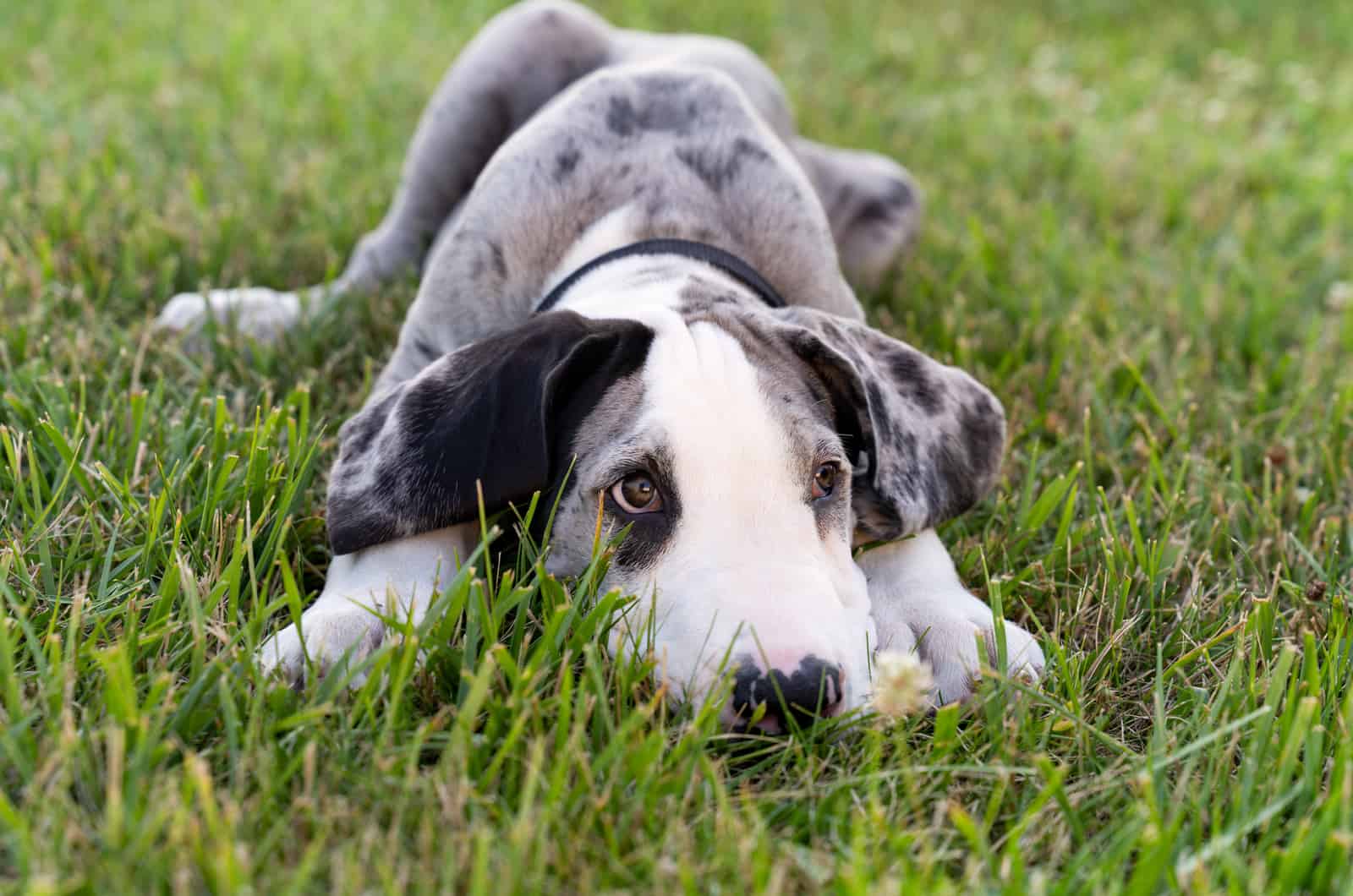
Merle is likely the most controversial of all Great Dane colors. Because of this, most breeders refrain from intentionally breeding and selling merle Great Dane puppies.
Merle Great Danes are similar to harlequin Great Danes, as both have splotches of color on a base coat of another color. The biggest difference is that merle Danes usually have a silver base coat, with black spots, and even some white markings on it.
Because of their grey coat, these dogs are also known as blue merle Great Danes.
Merle can happen with any other coat color. You can have a red merle, a fawn merle, and so on. However, blue merle is the only variant of the merle coat color that is fully acceptable.
This pattern is caused by the merle gene. Similar to the gene that causes a blue coat color, this is a dilution gene that lightens the base coat color. However, it doesn’t dilute it in the same way as other dilution genes do. Instead, it gives a canine the splotchy merle pattern. These dogs will typically also have heterochromia or entirely blue eyes.
However, the merle gene is so strong that it doesn’t dilute the coat and skin color only. Instead, it’ll dilute any pigment in the dog’s body, even his bones and some other tissues. Because of this, the merle patches have been connected with several health issues.
If a dog has only one pair of merle alleles, he’ll have the merle pattern, and he’ll most likely be fairly healthy. However, if he is a double merle, or rather, if he has a pair of merle alleles, this is where things get complicated.
Double merles usually don’t have the merle pattern. Instead, they are entirely white with blue eyes. At the same time, they have many health problems – most notably, deafness and heart complications.
Merle is a dominant gene, meaning it will express itself if it’s present in the dog’s DNA. However, some dogs are cryptic merles, and they are carriers of the merle gene, despite not being merles themselves. As such, getting a double merle can happen even if you don’t breed two merle dogs.
Because of this, most dog lovers who are familiar with this topic are strictly opposed to the idea of breeding merle dogs, even when the pattern is a part of the standard, such as in the case of the Great Dane breed.
Great Dane Merle Puppies
Merle puppies are born when a parent Great Dane of any color has a merle gene. This gene should be inherited from only one parent.
Otherwise, you’ll end up with a white puppy with health defects.
The base color of the parent dog will influence the color of the merle dog. If the base color is red, you’ll have a red merle, and so on.
Great Dane Blue Merle Puppies
Blue merle puppies are born when a black Great Dane has a merle dilution gene. As such, they are fairly rare because pure black Great Danes aren’t as popular as some other Great Dane colors.
These puppies have a grey base coat, with black and white spots on it. They might look like harlequin Great Danes, but the main difference is the base coat color, as well as the genetics behind it.
Rare Great Dane Colors
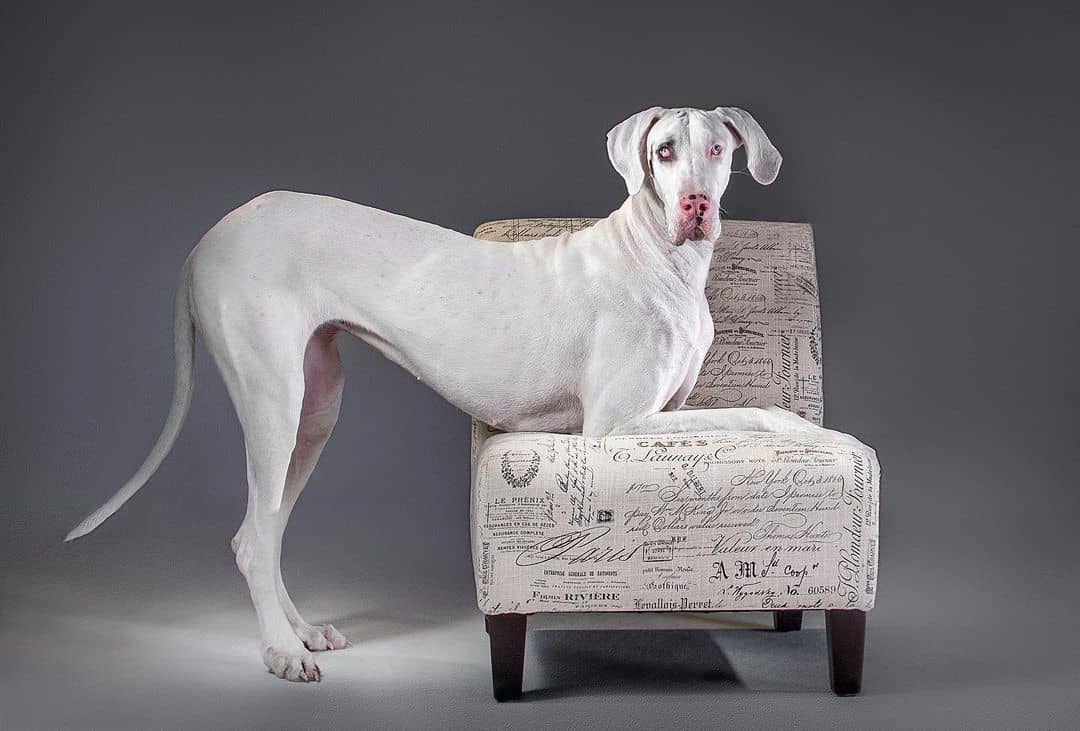
Photo from: @ali.nasser.photo
Other than standard colors, there are some colors that people look for that aren’t considered a breed standard. If we exclude some undesirable patterns, most of the time, this is because the color indicates that a Great Dane isn’t purebred, and these dogs aren’t desired within the shows.
While the Great Dane Club of America might allow you to register dogs in some of these shades, most of the Great Dane colors we’ll list below are entirely undesirable.
Here’s what they are:
White Great Danes
White Great Danes usually signify that a dog has some defect that has turned his coat white. This is the case with the aforementioned double merles, but also with albinism.
Most white Great Danes suffer from vision and hearing problems. Many will have a weak heart and bones, as well as other health issues. Because of this, a white coat is frowned upon.
Chocolate Great Danes
Chocolate, or liver, isn’t a color that is naturally found in Great Danes. It is the result of another dilution gene that dilutes the black color into a shade of brown.
Not all chocolate Great Danes will have a brown coat. However, all will have a brown nose, lips, paw pads, and eye rims. Also, amber and green eye colors are common.
See Also: 21 Dogs With Green Eyes You’ll Fall In Love With
Piebald Great Danes
Piebald Great Danes have a white base coat with markings of some other color – usually black. Most of these pups will have markings around their tail area.
The distribution and the amount of patterns are what set piebald Danes apart from mantle and harlequin dogs, as both accepted coat colors have a specific pattern that piebald doesn’t have.
Great Dane Tri Color
Great Danes don’t naturally come in tri color unless they are merle dogs. These pups are crossbreeds, and they will usually have some other features that will set them apart from purebred Danes.
Fawnequin Great Dane Colors
Fawnequin Great Danes have become increasingly popular in recent years. However, this pattern isn’t allowed according to the AKC’s standards.
Fawnequin dogs are, in fact, fawn-colored harlequins. They have a white base coat with patches of fawn markings. While the exact pattern varies, the markings are never spots, brindles, nor pied.
While this color is recognized, it doesn’t belong to the breed standard. As such, fawnequin dogs cannot participate in dog shows.
Genetics Behind The Great Dane Colors
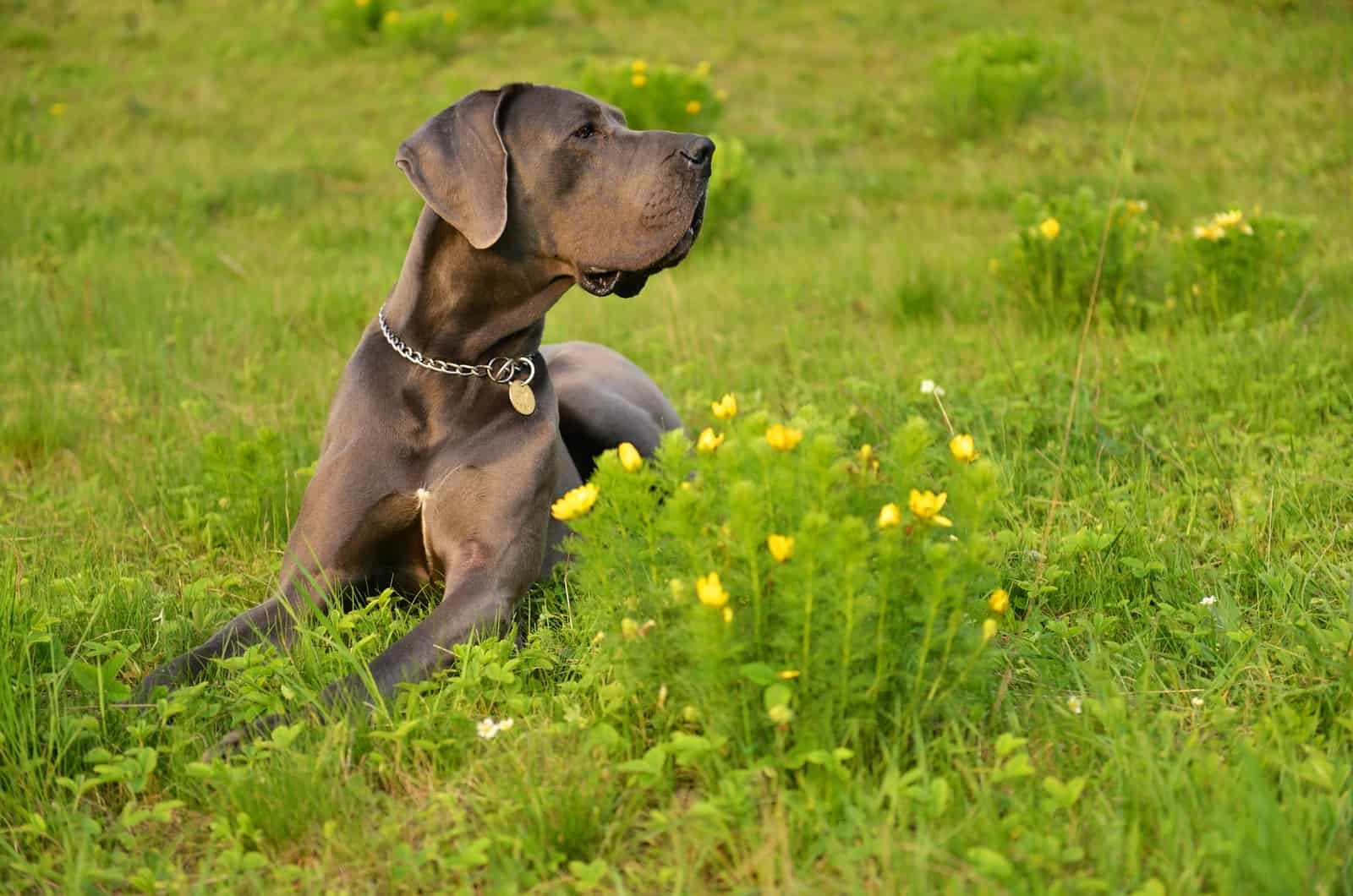
As you can see, there are many different Great Dane colors. All of them are caused by a specific combination of genes. Different genes can cause a black, merle, or harlequin coat. Even so, these genes still aren’t entirely clear, and there are many things that experts are yet to discover.
Still, we know most things about the genetics behind the Great Dane colors, and how they are passed on.
All living beings, including dogs, have genes that are located in a specific place on a chromosome. This location is known as a locus, or loci in the plural.
Each gene has two alleles that determine a specific physical trait. How the trait will manifest itself is called phenotype.
Dogs have two types of pigment in their skin and coat: eumelanin, which is responsible for black color, and phaeomelanin, which causes the color, red. The combination and the brightness of these two pigments result in all other Great Dane colors.
There are eight loci with genes that determine the coat color of the dog. These are:
• A locus, responsible for the coat patterns.
• E locus, which causes the black facial mask, but also red and yellow coats.
• K locus, which causes the most dominant coat colors, including black, brindle, and fawn coat • colors.
• B locus, linked to chocolate, brown, and liver colors.
• D locus, responsible for the dilution of the existing colors.
• M locus, which causes the merle pattern.
• H locus, associated with the harlequin pattern.
• S locus, linked to some patterns such as piebald, parti, and white spots.
Genes can be recessive and dominant. Dominant genes will always express themselves, while recessive genes will only have an influence on the dog’s appearance when they are paired with another recessive gene.
Each parent dog will pass on one gene to their puppy. The combination of these genes is what finally determines the dog’s appearance.
Show-Quality Vs. Pet-Quality Great Danes
As you can see, the biggest difference with some of these colors is whether or not they are accepted by the AKC as the breed standard. This can help you ensure that you have a purebred, healthy dog, but it can also be of importance if you decide to enroll your Great Dane in a dog show.
Only dogs of show quality have a chance in the show ring. While this isn’t important for people who are looking for a beloved family companion, it is essential for those who want a champion dog.
Overall, finding dogs that perfectly fit the color standards we’ve talked about is very rare. Most puppies will have some mismarks, and this is entirely normal. Dogs of all bloodlines can have some differences compared to what an ‘ideal’ dog should look like.
Even dogs with some ‘flaws’ in their appearance are still considered purebred. However, these will be sold as pet-quality dogs.
This isn’t to say that there is anything wrong with these dogs. They simply don’t possess the traits that judges of dog shows deem important, but that doesn’t mean they are worse dogs than the ones with markings on the wrong spot.
On the other hand, show-quality dogs possess all the traits of the breed standard. They are picture-perfect, and they showcase the best that the breed can be.
However, if you don’t plan on participating in dog shows, there really isn’t any need to pick a dog of show quality. These pups are usually more expensive than regular puppies, which can even make them inaccessible to a wider audience.
Still, it would be best to pick a dog that comes in recognized coat colors for the breed. This will ensure that you’ll get a purebred dog.
Of course, even if you choose a puppy with colors close to the breed standard, this is still perfectly safe.
Essentially, there is nothing wrong with choosing a mixed breed dog as well. However, if you want to buy a purebred Great Dane in a rare and exotic color, chances are you are being tricked, and that you’ve been sold a crossbreed, usually with a Mastiff or a Cane Corso.
Everyone should know what it is they’re buying, especially when it comes to living beings, such as dogs.
Are Great Dane Colors Important?
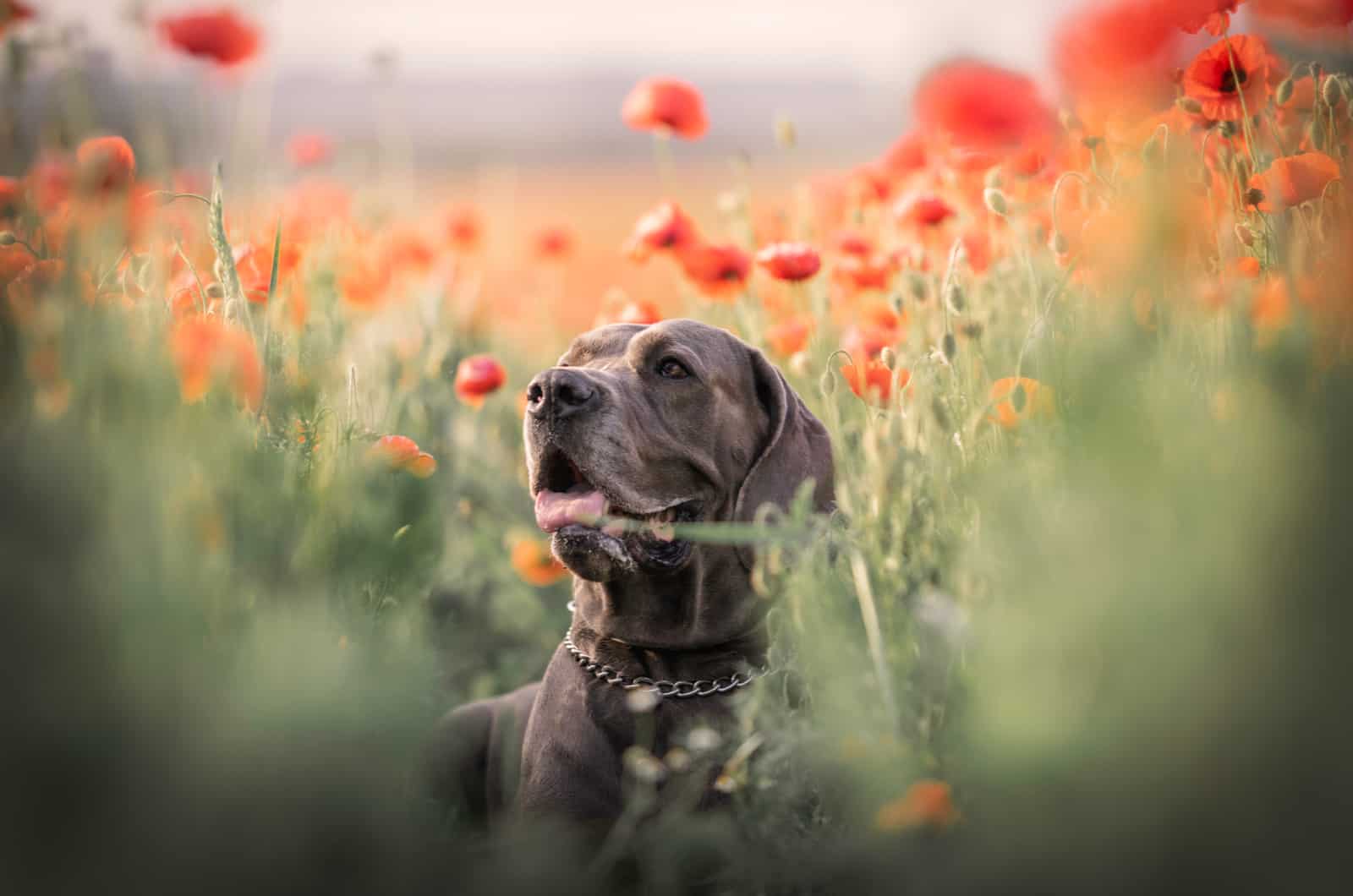
There have been some claims that dogs of a certain color are more aggressive or more loveable than others. In fact, black dogs are usually left behind at shelters because of the superstition that they are aggressive and bring bad luck to their owners.
However, not a single piece of research has managed to prove that Great Dane colors have anything to do with their temperament or personality.
No matter the color, Great Danes will be mellow dogs that will want nothing more than to sit on your lap all day long, despite their large size. They have a short coat that is easy to groom, but they do shed a bit, so they are not good for allergy sufferers.
What does affect the Great Dane temperament is the environment and the upbringing your pooch has. Yes, this also includes the dog’s owners and how they raised their pup.
There is a saying that there aren’t bad dogs, only bad owners. This is true in the case of Great Danes as well.
If you socialize your dog from an early age – especially if you’ve bought it from a good breeder who conducted socialization while the pup was still with his mother – and provided him with good training, you’ll have the best family companion by your side.
On the other hand, if you neglect your dog or let him live in inadequate conditions, chances are he’ll have some behavioral issues, even if he belongs to the friendliest of breeds.
As you can see, the only thing that Great Dane colors could affect is your pooch’s health, which is why there are some colors that should be avoided.
Other than that, feel free to pick a dog in the color of your preference. It truly doesn’t make any difference. All Great Danes make wonderful pets, and we are certain you won’t be sorry no matter what Great Dane color you choose.
